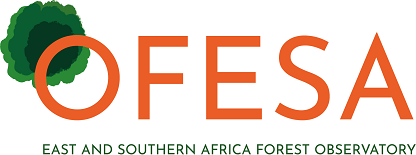Applying self-sustaining, low-cost and user-friendly software for forest monitoring in Tanzania

Rufiji District VNRC representatives (trainees), MJUMITA training team and OFESA team. Kelvin Shirima/MJUMITA.
One of the key activities of the East and Southern Africa Forest Observatory (OFESA) is working with local partners to support upscaling of low-cost forest monitoring initiatives in project countries by building the capacities of community scouts and forest rangers in the collection, analysis and transfer of data to a central database.
Mtandao wa Jamii wa Usimamizi wa Misitu Tanzania (MJUMITA), also known as the Community Forest Conservation Network of Tanzania is an independent NGO which provides technical support to local community-based organizations (CBOs) in villages involved in Participatory Forest Management (PFM) across Tanzania. Early this year, OFESA supported MJUMITA to upscale their activities on digitizing community forest monitoring activities.
Forest monitoring by communities and local forest officials is a key component of sustainable forest management. Existing key gaps such as disparities in access to technology, electricity, lack of information or feedback mechanism at the local level may inhibit the capacity of communities and local forest managers to undertake monitoring effectively.
Forest monitoring: A step-by-step process
The Rufiji upscaling process began with identifying the existing monitoring approach and gaps to be addressed. To determine these gaps, discussions were held with the Village Natural Resource Committee (VNRC) on two potential sites. Rufiji community forest was selected to upscale Mjumita’s monitoring activities and apply some of the dashboard tools.
Forest monitoring in Rufiji is carried out by members of the village resource committee in charge of patrol activities and the village governance evaluators who monitor the activities of the village natural resource committee. Before the current upgrade, the monitoring approach in place involved organized patrols conducted by members of the VNRC who collected data on forest threats/indicators such as illegal harvesting of forest products. The resulting information was recorded manually in a patrol book.
An analysis of this process revealed the need to improve the data collection process through technology by customizing the data collection template training on the mobile application for data collection and support with equipment. This led to the development of a web-based village forest and governance tool, made of five sub-tools: a Village Forest Patrol Form, a Forest Crime Tracking Form, a Sustainable Harvesting Tracking Form for Village Land Forest Reserves, a Tracking Village Meeting for discussing Village Forest Management, and a Tracking Village Report on village Notice Boards.
‘The approach used was low-cost monitoring, using ODK software to digitize community forest monitoring data collection because the software is free and simple to use for trained evaluators. Another software used was Avenza maps TM, which is free and can be used for navigation and mapping of areas of interest’, says Rahima Njaidi, MJUMITA’s Director.
Improving community capacity with knowledge and equipment
For the tool application process Mjumita purchased, three cellular phones and power banks for use in Rufiji, one for each village, which will be classified as village assets after the training. Next was the introduction of the tool at the district and village levels in the presence of 260 stakeholders (88 women and 172 men), including 25 members of the Council Management Team (CMT), 76 Village Council and Village Natural Resource members and 159 community members, after which an implementation strategy was adopted. A preliminary test and a review meeting for the developed tool was later conducted in Rufiji to determine its efficiency.
Thereafter, a two-day training was organized at Nyamwage Village, with modules being made easier with hands-on demonstrations of the tools applications. Facilitators projected their phones to allow participants to practice what was demonstrated by the facilitators in real-time using their phones. During the session, questions and discussions were held throughout the module to make sure participants were completely engaged and understood what was being taught.
Anticipating future needs, MJUMITA also incorporated modules – such as practical exercises on basic GIS use such as inputting coordinates navigation apps which will support mapping the community forest in the Rufiji area. From October 5th to 6th 2022, eighteen community leaders (10 men and 8 women) from Tawi, Nyamwage, and Mtanza msona villages were trained on the use of forest and governance monitoring tools. They included 10 village governance evaluators and 8 VNRC leaders.

ODK software demonstration training. Ivy Amugune/CIFOR-ICRAF
‘Collaboration with local forest conservation institutes in the project countries is necessary as this permits the provision of technical support on the upscale of low-cost community forest monitoring interventions. The main aim of the project’s actions is to address the current gaps that are identified in the forest hotspot areas and develop a feedback mechanism at the local level for local ownership and sustainability’, says Douglas Ombogoh, Research Officer at CIFOR-ICRAF.
The tool's implementation is currently in progress and discussions around customizing the existing dashboard are underway. MJUMITA will receive data collected during the various patrol activities using the equipment provided. This information will be transferred to the MJUMITA server for storage, future use, and access by national forest bodies and other stakeholders.





